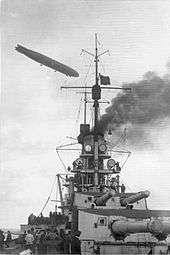Operation Albion
| Operation Albion | |||||||
|---|---|---|---|---|---|---|---|
| Part of World War I | |||||||
 Operation Albion amphibious operations 10–20 October | |||||||
| |||||||
| Belligerents | |||||||
|
|
| ||||||
| Commanders and leaders | |||||||
|
|
| ||||||
| Strength | |||||||
|
1 Battlecruiser |
2 Pre-dreadnought battleships | ||||||
| Casualties and losses | |||||||
|
1 Torpedo boat destroyed |
Battleship Slava destroyed | ||||||


Operation Albion was the German land and naval operation in September–October 1917 to invade and occupy the West Estonian Archipelago, then part of the Autonomous Governorate of Estonia, Russian Republic. The land campaign opened with landings at the Tagalaht, Saaremaa on 11 October 1917, after extensive naval activity to clear mines and subdue coastal artillery batteries. The Germans secured the island by 16 October. The Russian Army evacuated Muhu on 18 October.
After two failed attempts, the Germans managed to land on Hiiumaa on the 19th and captured the island on the following day. The Russian Baltic Fleet had to withdraw from the Suur Strait after major losses (see Battle of Moon Sound). The Germans claimed 20,000 prisoners and 100 guns captured during the Operation Albion from 12 October.
Strategic significance
At the beginning of World War I the islands were of little importance to either Imperial Russia or Germany. However, after the revolutionary turmoil in Russia during 1917, the German high command believed capturing the islands would outflank Russian defences and lay St. Petersburg vulnerable to attack.[1]
Order of battle
German units
- 42nd Division
- 2nd Infanterie Cyclist Brigade
- Sonderverband (Special Task force): "Vizeadmiral' Ehrhard Schmidt
- Flagship: Moltke
- III. Geschwader: Vizeadmiral Paul Behncke in command of dreadnought battleships König, Bayern, Grosser Kurfürst, Markgraf, and Kronprinz
- IV. Geschwader: Vizeadmiral Wilhelm Souchon in command of dreadnought battleships Kaiser, Friedrich der Grosse, Kaiserin, Prinzregent Luitpold, and König Albert
- II. Aufklärungsgruppe: Konteradmiral Ludwig von Reuter in command of cruisers Königsberg, Karlsruhe, Danzig, Frankfurt, and Nürnberg
- VI. Aufklärungsgruppe: Konteradmiral Albert Hopman in command of cruisers Kolberg, Strassburg, Augsburg, Nautilus, and Blitz
- Torpedoboats Flagship: Emden
- II Flottille (10 boats)
- VIII Flottille (11 boats)
- VI Flottille (11 boats)
- X Flottille (11 boats)
- 7th Half-Flottille (7 boats)
- U-Flottille Kurland (6 boats)
- Sperrbrechergruppe.
- II Minesweeper Flottille
- 3rd Half-Flottille
- 4th Half-Flottille
- 8th Half-Flottille
- 3rd Such-Half-Flottille
- Such-Flottille of the Baltic
- Netbarrier Unit of the Baltic
Russian units[2]
- 425th, 426th and 472nd Infantry Regiments
- Battleships: Tsesarevich, Slava
- Armored cruiser: Admiral Makarov
- Destroyers: Desna, Novik, Pobeditel, Zabijaka, Grom, Konstantin
- Gunboats: Chivinetz, Grozyashchi
- Blockship: Lavwija
- Minelayer: Pripyat
British units
See also
References
Notes
- ↑ Barrett (2008), p8
- ↑ Operation Albion: The Attack On The Baltic Islands
Bibliography
- Barrett, Michael B. Operation Albion: The German Conquest of the Baltic Islands. Indiana University Press: Bloomington, IN. 2008. ISBN 978-0-253-34969-9
External links
| Wikimedia Commons has media related to Operation Albion. |
- 1 October entries on this site summarise Operation Albion
- Detailed account of Operation Albion
- "Oesel Genommen", film footage of the invasion in 1917 from the German Federal Archives